Yinfeng Li
SynapseRoute: An Auto-Route Switching Framework on Dual-State Large Language Model
Jul 03, 2025Abstract:With the widespread adoption of large language models (LLMs) in practical applications, selecting an appropriate model requires balancing not only performance but also operational cost. The emergence of reasoning-capable models has further widened the cost gap between "thinking" (high reasoning) and "non-thinking" (fast, low-cost) modes. In this work, we reveal that approximately 58% of medical questions can be accurately answered by the non-thinking mode alone, without requiring the high-cost reasoning process. This highlights a clear dichotomy in problem complexity and suggests that dynamically routing queries to the appropriate mode based on complexity could optimize accuracy, cost-efficiency, and overall user experience. Based on this, we further propose SynapseRoute, a machine learning-based dynamic routing framework that intelligently assigns input queries to either thinking or non-thinking modes. Experimental results on several medical datasets demonstrate that SynapseRoute not only improves overall accuracy (0.8390 vs. 0.8272) compared to the thinking mode alone but also reduces inference time by 36.8% and token consumption by 39.66%. Importantly, qualitative analysis indicates that over-reasoning on simpler queries can lead to unnecessary delays and even decreased accuracy, a pitfall avoided by our adaptive routing. Finally, this work further introduces the Accuracy-Inference-Token (AIT) index to comprehensively evaluate the trade-offs among accuracy, latency, and token cost.
ELASTIC: Efficient Linear Attention for Sequential Interest Compression
Aug 20, 2024



Abstract:State-of-the-art sequential recommendation models heavily rely on transformer's attention mechanism. However, the quadratic computational and memory complexities of self attention have limited its scalability for modeling users' long range behaviour sequences. To address this problem, we propose ELASTIC, an Efficient Linear Attention for SequenTial Interest Compression, requiring only linear time complexity and decoupling model capacity from computational cost. Specifically, ELASTIC introduces a fixed length interest experts with linear dispatcher attention mechanism which compresses the long-term behaviour sequences to a significantly more compact representation which reduces up to 90% GPU memory usage with x2.7 inference speed up. The proposed linear dispatcher attention mechanism significantly reduces the quadratic complexity and makes the model feasible for adequately modeling extremely long sequences. Moreover, in order to retain the capacity for modeling various user interests, ELASTIC initializes a vast learnable interest memory bank and sparsely retrieves compressed user's interests from the memory with a negligible computational overhead. The proposed interest memory retrieval technique significantly expands the cardinality of available interest space while keeping the same computational cost, thereby striking a trade-off between recommendation accuracy and efficiency. To validate the effectiveness of our proposed ELASTIC, we conduct extensive experiments on various public datasets and compare it with several strong sequential recommenders. Experimental results demonstrate that ELASTIC consistently outperforms baselines by a significant margin and also highlight the computational efficiency of ELASTIC when modeling long sequences. We will make our implementation code publicly available.
A minimal coalition logic
Mar 17, 2024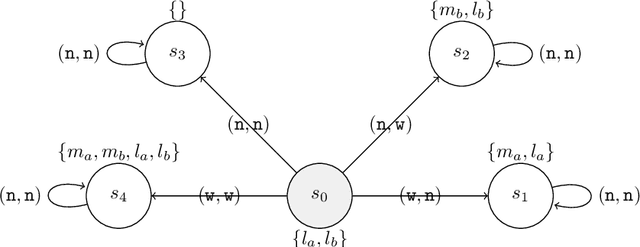
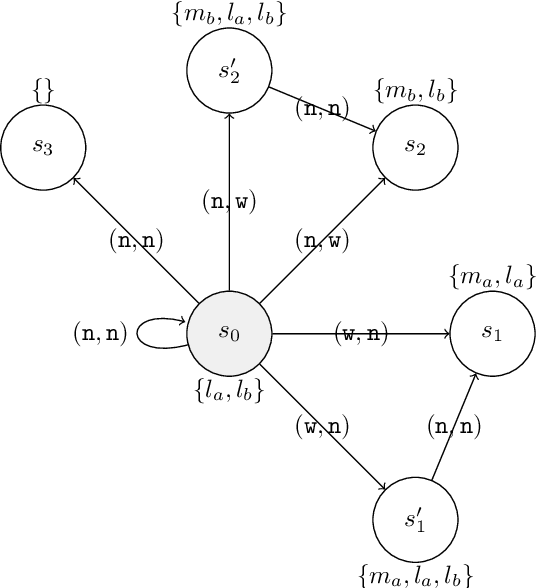
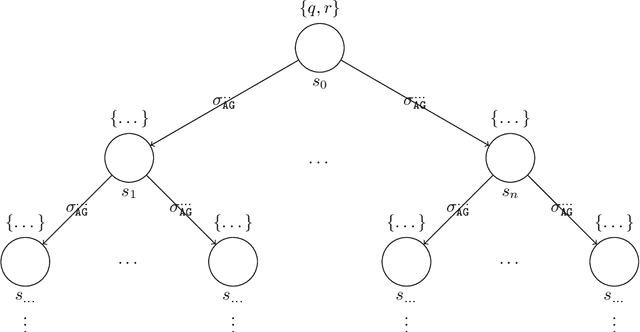
Abstract:Coalition logic is a central logic in strategic reasoning studies. In this paper, we first argue that Coalition Logic models, concurrent game models, have three too-strong assumptions. The first one is the independence of agents; that is, the merge of two available joint actions of two disjoint coalitions is always available for the union of the two coalitions. The second one is seriality; that is, coalitions always have available joint actions. The third one is determinism, that is, the grand coalition's joint actions always have a unique outcome. Second, we present a coalition logic based on general concurrent game models, which do not have the three assumptions. We show the completeness of this logic and compare it with Coalition Logic in detail. This logic seems minimal in the context of strategic reasoning.
Inverse Learning with Extremely Sparse Feedback for Recommendation
Nov 20, 2023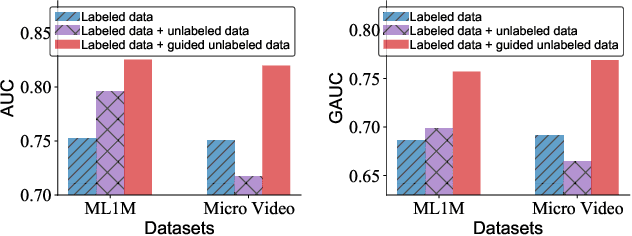
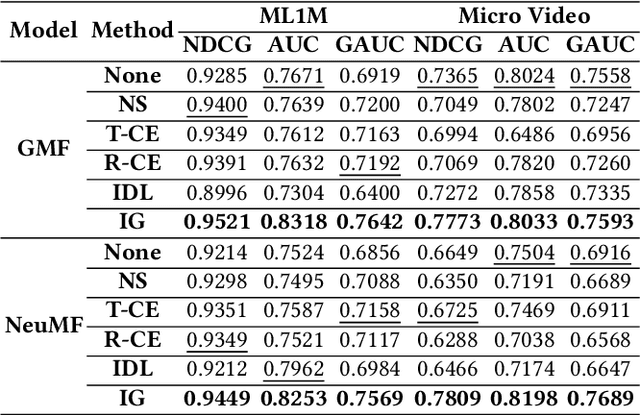
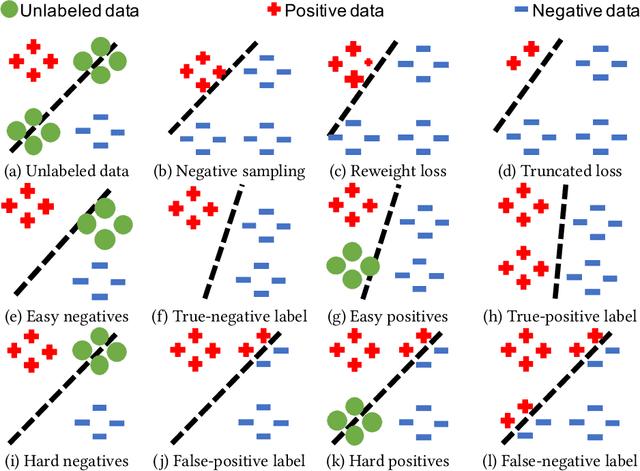

Abstract:Modern personalized recommendation services often rely on user feedback, either explicit or implicit, to improve the quality of services. Explicit feedback refers to behaviors like ratings, while implicit feedback refers to behaviors like user clicks. However, in the scenario of full-screen video viewing experiences like Tiktok and Reels, the click action is absent, resulting in unclear feedback from users, hence introducing noises in modeling training. Existing approaches on de-noising recommendation mainly focus on positive instances while ignoring the noise in a large amount of sampled negative feedback. In this paper, we propose a meta-learning method to annotate the unlabeled data from loss and gradient perspectives, which considers the noises in both positive and negative instances. Specifically, we first propose an Inverse Dual Loss (IDL) to boost the true label learning and prevent the false label learning. Then we further propose an Inverse Gradient (IG) method to explore the correct updating gradient and adjust the updating based on meta-learning. Finally, we conduct extensive experiments on both benchmark and industrial datasets where our proposed method can significantly improve AUC by 9.25% against state-of-the-art methods. Further analysis verifies the proposed inverse learning framework is model-agnostic and can improve a variety of recommendation backbones. The source code, along with the best hyper-parameter settings, is available at this link: https://github.com/Guanyu-Lin/InverseLearning.
Dual Contrastive Network for Sequential Recommendation with User and Item-Centric Perspectives
Sep 18, 2022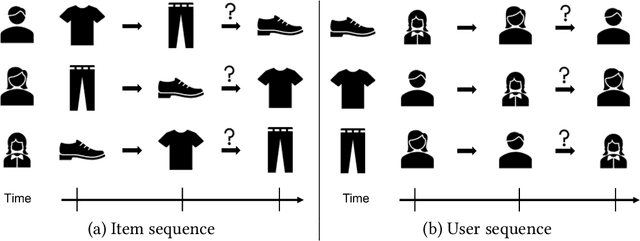
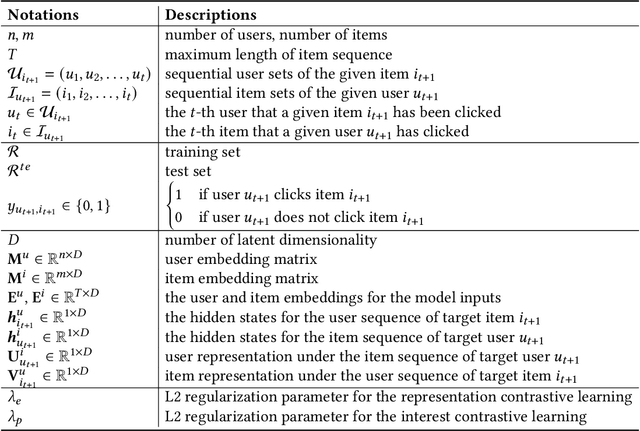
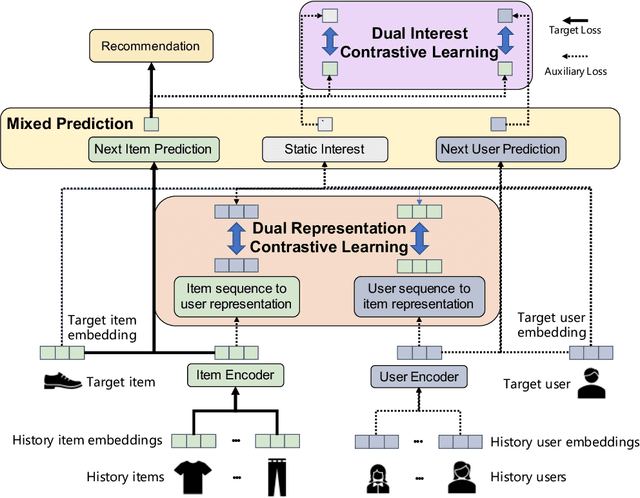

Abstract:With the outbreak of today's streaming data, sequential recommendation is a promising solution to achieve time-aware personalized modeling. It aims to infer the next interacted item of given user based on history item sequence. Some recent works tend to improve the sequential recommendation via randomly masking on the history item so as to generate self-supervised signals. But such approach will indeed result in sparser item sequence and unreliable signals. Besides, the existing sequential recommendation is only user-centric, i.e., based on the historical items by chronological order to predict the probability of candidate items, which ignores whether the items from a provider can be successfully recommended. The such user-centric recommendation will make it impossible for the provider to expose their new items and result in popular bias. In this paper, we propose a novel Dual Contrastive Network (DCN) to generate ground-truth self-supervised signals for sequential recommendation by auxiliary user-sequence from item-centric perspective. Specifically, we propose dual representation contrastive learning to refine the representation learning by minimizing the euclidean distance between the representations of given user/item and history items/users of them. Before the second contrastive learning module, we perform next user prediction to to capture the trends of items preferred by certain types of users and provide personalized exploration opportunities for item providers. Finally, we further propose dual interest contrastive learning to self-supervise the dynamic interest from next item/user prediction and static interest of matching probability. Experiments on four benchmark datasets verify the effectiveness of our proposed method. Further ablation study also illustrates the boosting effect of the proposed components upon different sequential models.
DisenHCN: Disentangled Hypergraph Convolutional Networks for Spatiotemporal Activity Prediction
Aug 14, 2022



Abstract:Spatiotemporal activity prediction, aiming to predict user activities at a specific location and time, is crucial for applications like urban planning and mobile advertising. Existing solutions based on tensor decomposition or graph embedding suffer from the following two major limitations: 1) ignoring the fine-grained similarities of user preferences; 2) user's modeling is entangled. In this work, we propose a hypergraph neural network model called DisenHCN to bridge the above gaps. In particular, we first unify the fine-grained user similarity and the complex matching between user preferences and spatiotemporal activity into a heterogeneous hypergraph. We then disentangle the user representations into different aspects (location-aware, time-aware, and activity-aware) and aggregate corresponding aspect's features on the constructed hypergraph, capturing high-order relations from different aspects and disentangles the impact of each aspect for final prediction. Extensive experiments show that our DisenHCN outperforms the state-of-the-art methods by 14.23% to 18.10% on four real-world datasets. Further studies also convincingly verify the rationality of each component in our DisenHCN.
Graph Neural Networks for Recommender Systems: Challenges, Methods, and Directions
Sep 27, 2021



Abstract:Recommender system is one of the most important information services on today's Internet. Recently, graph neural networks have become the new state-of-the-art approach of recommender systems. In this survey, we conduct a comprehensive review of the literature in graph neural network-based recommender systems. We first introduce the background and the history of the development of both recommender systems and graph neural networks. For recommender systems, in general, there are four aspects for categorizing existing works: stage, scenario, objective, and application. For graph neural networks, the existing methods consist of two categories, spectral models and spatial ones. We then discuss the motivation of applying graph neural networks into recommender systems, mainly consisting of the high-order connectivity, the structural property of data, and the enhanced supervision signal. We then systematically analyze the challenges in graph construction, embedding propagation/aggregation, model optimization, and computation efficiency. Afterward and primarily, we provide a comprehensive overview of a multitude of existing works of graph neural network-based recommender systems, following the taxonomy above. Finally, we raise discussions on the open problems and promising future directions of this area. We summarize the representative papers along with their codes repositories in https://github.com/tsinghua-fib-lab/GNN-Recommender-Systems.
 Add to Chrome
Add to Chrome Add to Firefox
Add to Firefox Add to Edge
Add to Edge